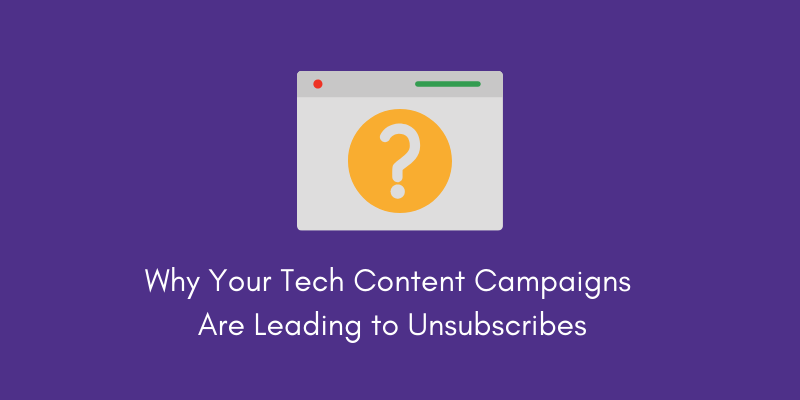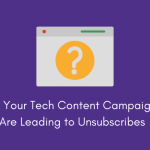In our #wfh #coronavirus new world, every content marketing professional must be asking themselves some version of the question, “What’s our messaging now?”
But, really the questions behind that question are likely:
- Is it okay to want or expect new sales or clients during a global crisis?
- Is it okay still to reach out to prospective clients about my business? How do I appropriately follow up?
- If I do communicate to prospective clients or buyers, do I mention Covid-19? Do I avoid the topic completely? Am I an asshole for mentioning it or an asshole for not?
In general, I try to practice content marketing the way I try to practice life, which is with as much authenticity, generosity, and empathy as possible. I throw in humor where and when I can. And, finally, I do my best to read the room, which in this case means listening very closely to the online conversations other content marketing professionals are having about content creation right now.
The listening is the most critical ingredient to a successful content marketing strategy during a crisis (if not always). So many companies feel the urge to “talk” right now; my inbox has been flooded with communications.
In my case, all these communications are working against those brands. I’ve never hit unsubscribe as much as I have the last two weeks.
Is it that unsubscribing is a distraction? A swift and easy motion that makes me feel like I am achieving something? Being proactive about something work-related?
Or is that I’m subconsciously or consciously offended by the especially-useless-to-me-right-now content that is flowing through all channels with seeming disregard to the varying degrees of anxiety and fear most of us are living in?
When you are in survival mode, your eyes glaze right over any information your brain interprets as useless to your survival.
Fight-flight-or-freeze in the workplace can very much look like hitting delete before reading your content or ignoring it altogether.
My suggestion? Quiet down for a moment. Stop talking. Listen. Be an island of calm in a sea of frantic marketing chatter.
How to Succeed in Creating a Sense of Listening Through a Text-based Communication
Without live eye contact and body language, both of which are absent in emails and blog posts, the best way to communicate a sense of listening is by asking questions.

The best question to ask during a time of crisis, particularly if you yourself are not in imminent danger:
How can I help you?
Have you sent out a correspondence to your current client list that asks this very question? For one, it’s the empathetic, human-focused action to take. But, two, their answers may lead you to the best content to produce when seeking new business during this time.
But Is Marketing During a Global Crisis Insensitive?
As to whether or not you are an asshole for mentioning or not mentioning Covid-19 in your direct mail communications, consider how you email or message your business contacts under typical conditions: Do you kick off an email to an acquaintance with a pitch or do you offer at least a cursory “how are you?”
Most of us start off a professional correspondence with some kind of greeting-question. This may seem obvious, but it’s not obvious to everyone considering some of the LinkedIn messages I’ve received the last two weeks.
We should set some context for our direct mail communications during a global pandemic; people are losing jobs, friends, and lives. If you can’t find a way to comfortably create context in your messaging, consider postponing all direct mail campaigns until it “feels” to your leadership team that it’s okay to send an email about efficiently migrating to cloud without mentioning the fact that the sky is falling.
Again: I can’t emphasize enough. Read the room.
When it comes to blog posts, which are inherently less direct and therefore less personal, I suggest you review your content calendar for the next three months–examine the topics and briefs of each new piece of content you were intending to publish–and ask yourself the question: how does this article help my target audience right now? Does it still?
If it does, proceed. Tech experts, who appear to be in great demand now, still need how-tos, tips, and comparisons. (This also means they still likely need your product or solution, so creating tech-focused content for your blog can benefit you now and in the long-term.)
If it doesn’t, table that piece for now. (The good news is you will probably be able to use that topic / article in a few months.) Do a mini content strategy session with your stakeholders. Brainstorm with your SMEs what kind of content would be particularly helpful to your readers during a crisis like this one.
Here at IOD, we are having the same kind of conversations you are likely having with your team. We want to know how we can help companies that find themselves unexpectedly re-evaluating their marketing strategies for 2020, CMOs who undoubtedly are shifting budget from, let’s say events, to digital, without being predatory. Yes, IOD is a business, but our values dictate that our behavior is not solely motivated by profit. To that end, we’re asking everyone in our ecosystem –not only our clients, but also our freelancers–“how can we help you right now?”
Don’t Forget to Lead with Authenticity
I can smell inauthenticity a mile away. I can’t stand, for instance, the coronavirus-campaigns we’re already seeing on television for cars, fast food, and luxury items.
On the other hand, brands that have been focusing on human-centric corporate communications and community service efforts–companies like McDonald’s, Serta Simmons Bedding, and Proctor & Gamble donating much-needed equipment to medical centers and hospitals–go a long way toward gaining my respect and trust.
These types of efforts always have secondary marketing & PR benefits.Of course, you and I may disagree over what feels authentic and what doesn’t, so it’s not an exact science. (Just yesterday, IOD’s CEO Ofir Nachmani and I were talking about IOD marketing initiatives and one idea I had, which came from a deeply genuine desire to connect meaningfully with our prospects, smelled to him like a “cheap trick.” Lesson learned? Ask around before launching a new marketing project right now.) More often than not, though, an attempt to authentically offer help, time, or useful services/tips at no cost is usually well received.
If you’re in need of a partner to brainstorm how you can sensitively market your tech brand online right now, please reach out to us. We really want to know:
How can IOD help?






